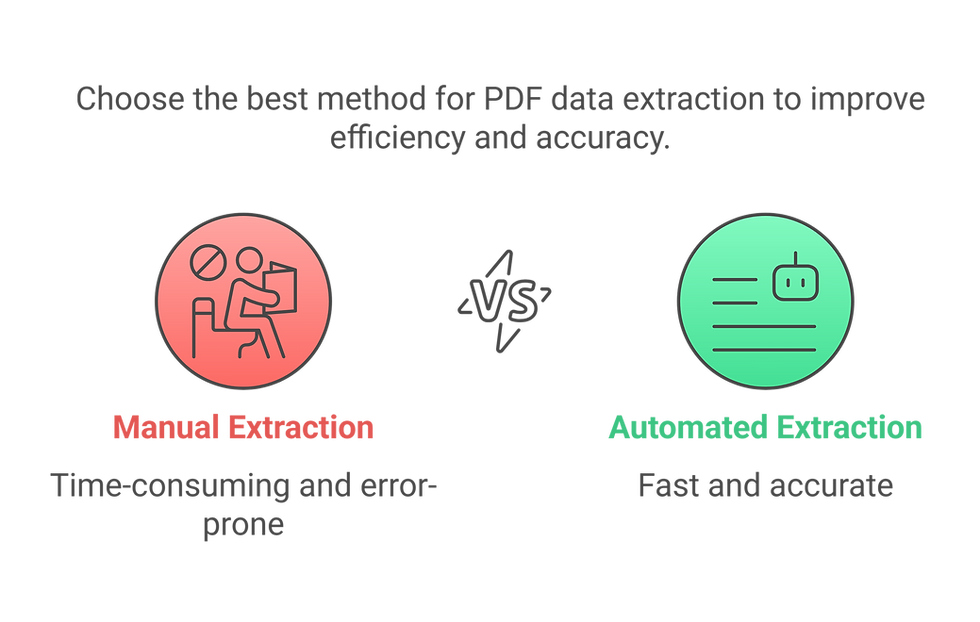
Unlocking the Power of Your Documents
Businesses today handle vast amounts of data, much of which is stored in PDF format. Whether it’s financial statements, invoices, contracts, or purchase orders, PDFs have become the standard for document sharing. However, PDFs are not built for easy data manipulation. Extracting information from them manually can be frustrating, time-consuming, and error-prone. When businesses rely on manual processes to retrieve crucial information, it often leads to inefficiencies that slow down decision-making and introduce unnecessary costs.
Traditional data extraction methods involve employees spending hours copying and pasting content into spreadsheets or databases. The process is tedious and, more importantly, highly prone to errors. Even a minor mistake in financial records or compliance documents can result in costly consequences. The need for a faster, more accurate solution has never been greater. Fortunately, automation makes it possible to streamline PDF data extraction, transforming hours of manual work into seconds of automated processing.
The Problem with Manual Data Extraction
For many organizations, extracting data from PDFs remains a bottleneck in their workflow. Employees must sift through pages of information, manually enter details into systems, and double-check for accuracy. This not only consumes valuable time but also diverts attention from more strategic tasks. Furthermore, human errors are inevitable, and even a minor miscalculation can cause significant operational disruptions. Companies that handle large volumes of data, such as those in finance, logistics, healthcare, and legal sectors, are particularly affected. The inability to efficiently process information can result in missed opportunities, compliance risks, and operational inefficiencies.
How Automated Data Extraction Works
Automated data extraction solutions like Virtualflow simplify this process by using artificial intelligence and machine learning to extract structured data from PDFs. The process is straightforward. Users upload their PDFs, and AI-driven technology scans the documents, identifies key information, and converts unstructured text into structured data. The extracted data is then formatted for seamless integration into databases, accounting software, or ERP systems. With real-time processing, businesses can access accurate, structured data within seconds, eliminating the delays caused by manual entry.
Who Benefits from PDF Data Extraction?
A wide range of industries can take advantage of automated PDF extraction. In finance and accounting, businesses can extract figures from invoices and receipts to streamline bookkeeping. Logistics companies benefit from processing freight documents, purchase orders, and customs declarations more efficiently. Retail and e-commerce businesses can automate inventory tracking and sales reports, while the healthcare industry can digitize patient records and insurance claims for faster processing. Legal professionals can quickly organize information from contracts and compliance documents, and the education sector can automate the collection of student records and administrative paperwork.
The Advantages of Automating PDF Data Extraction
By eliminating manual data entry, businesses can significantly speed up workflows. Instead of spending hours extracting information, employees can focus on tasks that require higher-level decision-making. Automation also reduces human error, ensuring accuracy and consistency in extracted data. Cost savings become evident as employee time is redirected toward more productive work. Moreover, automated solutions scale effortlessly, accommodating businesses that process anywhere from a few documents per week to thousands per day.
Another major advantage is improved decision-making. Clean, structured data enables businesses to generate insights more quickly, enhancing their ability to react to market trends and internal needs. Regulatory compliance is another crucial factor, as automation helps maintain standardized records, reducing the risk of non-compliance penalties. Additionally, customers benefit from faster service delivery, as automated processes enable businesses to respond more efficiently to inquiries and transactions.
The Hidden Costs of Manual Data Entry
Many companies underestimate the true cost of manual data extraction. Beyond the obvious labor expenses, hidden costs include opportunity costs from employees focusing on mundane tasks instead of innovation and strategy. Compliance risks also increase, as errors in regulatory reports can result in fines. Slow response times due to inefficient data processing can lead to missed business opportunities and reduced customer satisfaction. By switching to automation, businesses not only save money but also gain a competitive edge by leveraging faster and more reliable data handling.
Why Virtualflow?
Unlike basic OCR tools that merely recognize text, Virtualflow provides an advanced AI-powered solution that structures data intelligently and integrates seamlessly with business systems. Designed for non-technical users, Virtualflow requires no coding knowledge and is easy to implement. Its key benefits include high accuracy through machine learning models that continuously improve over time, customizable workflows to fit business-specific requirements, and cloud-based access for secure document processing from anywhere. Additionally, Virtualflow supports multi-document processing, allowing businesses to extract data from multiple PDFs simultaneously. With seamless integration into accounting, ERP, and CRM systems, the extracted data can be used immediately for decision-making and automation.

Final Thoughts
Data should never be locked inside PDFs. By automating data extraction, businesses can eliminate inefficiencies, reduce errors, and enhance decision-making capabilities. Whether dealing with invoices, reports, or contracts, Virtualflow makes it easy to retrieve and utilize information accurately and instantly. With AI-driven automation, companies can remove the barriers of manual data handling, improve compliance, and scale their operations effortlessly.
The future of data extraction is here. Instead of spending hours on manual entry, businesses can now streamline their workflow with Virtualflow and focus on what truly matters.

TL;DR (Summary)
Manual data extraction from PDFs is time-consuming, error-prone, and inefficient.
Automation speeds up workflows, reduces costs, and eliminates human error.
Virtualflow extracts and structures data seamlessly, integrating with business systems.
Industries like finance, logistics, retail, and healthcare benefit from automated PDF extraction.
Hidden costs of manual entry include opportunity costs, compliance risks, and slow processing times.
AI-driven automation enhances efficiency, compliance, and customer satisfaction.
Virtualflow provides a scalable, cloud-based, and no-code solution for businesses of all sizes.

Comments